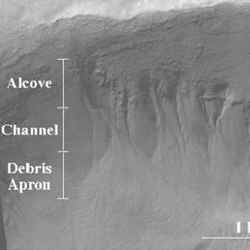
Image credit: Joseph Caruana. Click to enlarge

Space and astronomy news

Image credit: Joseph Caruana. Click to enlarge

Image credit: Shevill Mathers. Click to enlarge

Image credit: Michael Good. Click to enlarge

Artist’s concept of humans set off to Mars. Image credit: NASA Click to enlarge
After reading this article, you might never look at trash bags the same way again.
We all use plastic trash bags; they’re so common that we hardly give them a second thought. So who would have guessed that a lowly trash bag might hold the key to sending humans to Mars?
Most household trash bags are made of a polymer called polyethylene. Variants of that molecule turn out to be excellent at shielding the most dangerous forms of space radiation. Scientists have long known this. The trouble has been trying to build a spaceship out of the flimsy stuff.
But now NASA scientists have invented a groundbreaking, polyethylene-based material called RXF1 that’s even stronger and lighter than aluminum. “This new material is a first in the sense that it combines superior structural properties with superior shielding properties,” says Nasser Barghouty, Project Scientist for NASA’s Space Radiation Shielding Project at the Marshall Space Flight Center.
To Mars in a plastic spaceship? As daft as it may sound, it could be the safest way to go.
Less is more
Protecting astronauts from deep-space radiation is a major unsolved problem. Consider a manned mission to Mars: The round-trip could last as long as 30 months, and would require leaving the protective bubble of Earth’s magnetic field. Some scientists believe that materials such as aluminum, which provide adequate shielding in Earth orbit or for short trips to the Moon, would be inadequate for the trip to Mars.
Barghouty is one of the skeptics: “Going to Mars now with an aluminum spaceship is undoable,” he believes.
Plastic is an appealing alternative: Compared to aluminum, polyethylene is 50% better at shielding solar flares and 15% better for cosmic rays.
The advantage of plastic-like materials is that they produce far less “secondary radiation” than heavier materials like aluminum or lead. Secondary radiation comes from the shielding material itself. When particles of space radiation smash into atoms within the shield, they trigger tiny nuclear reactions. Those reactions produce a shower of nuclear byproducts — neutrons and other particles — that enter the spacecraft. It’s a bit like trying to protect yourself from a flying bowling ball by erecting a wall of pins. You avoid the ball but get pelted by pins. “Secondaries” can be worse for astronauts’ health than the original space radiation!
Ironically, heavier elements like lead, which people often assume to be the best radiation shielding, produce much more secondary radiation than lighter elements like carbon and hydrogen. That’s why polyethylene makes good shielding: it is composed entirely of lightweight carbon and hydrogen atoms, which minimizes secondaries.
These lighter elements can’t completely stop space radiation. But they can fragment the incoming radiation particles, greatly reducing the harmful effects. Imagine hiding behind a chain-link fence to protect yourself in a snowball fight: You’ll still get some snow on you as tiny bits of snowball burst through the fence, but you won’t feel the sting of a direct hit from a hard-packed whopper. Polyethylene is like that chain link fence.
“That’s what we can do. Fragmenting — without producing a lot of secondary radiation — is actually where the battle is won or lost,” Barghouty says.
Made to order
Despite their shielding power, ordinary trash bags obviously won’t do for building a spaceship. So Barghouty and his colleagues have been trying to beef-up polyethylene for aerospace work.
That’s how Shielding Project researcher Raj Kaul, working together with Barghouty, came to invent RXF1. RXF1 is remarkably strong and light: it has 3 times the tensile strength of aluminum, yet is 2.6 times lighter — impressive even by aerospace standards.
“Since it is a ballistic shield, it also deflects micrometeorites,” says Kaul, who had previously worked with similar materials in developing helicopter armor. “Since it’s a fabric, it can be draped around molds and shaped into specific spacecraft components.” And because it’s derived from polyethylene, it’s an excellent radiation shield as well.
The specifics of how RXF1 is made are secret because a patent on the material is pending.
Strength is only one of the traits that the walls of a spaceship must have, Barghouty notes. Flammability and temperature tolerance are also important: It doesn’t matter how strong a spaceship’s walls are if they melt in direct sunlight or catch fire easily. Pure polyethylene is very flammable. More work is needed to customize RXF1 even further to make it flame and temperature resistant as well, Barghouty says.
The Bottom Line
The big question, of course, is the bottom line: Can RXF1 carry humans safely to Mars? At this point, no one knows for sure.
Some “galactic cosmic rays are so energetic that no reasonable amount of shielding can stop them,” cautions Frank Cucinotta, NASA’s Chief Radiation Health Officer. “All materials have this problem, including polyethylene.”
Cucinotta and colleagues have done computer simulations to compare the cancer risk of going to Mars in an aluminum ship vs. a polyethylene ship. Surprisingly, “there was no significant difference,” he says. This conclusion depends on a biological model which estimates how human tissue is affected by space radiation–and therein lies the rub. After decades of spaceflight, scientists still don’t fully understand how the human body reacts to cosmic rays. If their model is correct, however, there could be little practical benefit to the extra shielding polyethylene provides. This is a matter of ongoing research.
Because of the many uncertainties, dose limits for astronauts on a Mars mission have not been set, notes Barghouty. But assuming that those dose limits are similar to limits set for Shuttle and Space Station flights, he believes RXF1 could hypothetically provide adequate shielding for a 30 month mission to Mars.
Today, to the dump. Tomorrow, to the stars? Polyethylene might take you farther than you ever imagined.
Original Source: NASA News Release

GALEX , one of the telescopes that will study AE Aqr. Image credit: NASA Click to enlarge
Amateur astronomers are being asked to help a constellation of observatories unravel the mysteries of a puzzling binary star system.
On August 30-August 31, 2005 two space-based and four professional ground-based observatories are scheduled to observe the cataclysmic variable star AE Aqr. Each of the observatories covers a different wavelength of light and amateur astronomers have been asked to help cover the visible-light portion.
“This observing campaign will take place over nearly a full day, and since no single ground-based observatory can observe AE Aqr for that long due to Earth’s rotation, amateur astronomers can make a unique and invaluable contribution to this campaign,” said Dr. Christopher Mauche of Lawrence Livermore National Laboratory, the principal investigator of the project.
Because they are spaced all across the globe, amateur astronomers can observe this star and other celestial objects unhindered by nightfall or weather.
The Chandra and GALEX space telescopes will be working with the HESS, MAGIC, VLT, and VLA ground-based telescopes. Combined, they will provide coverage of AE Aqr from high-energy gamma-rays to low-energy radio waves. Such simultaneous multiwavelength coverage is required to provide the clearest picture of the locations, mass motions, energetics, and inter-relationships of the various emission regions in the star.
AE Aqr is an intermediate polar, a type of cataclysmic variable star. It actually consists of two stars – a red dwarf and rapidly spinning magnetic white dwarf. Material drawn off the red dwarf falls toward the white dwarf, but instead of landing on the white dwarf surface, it is flung out of the system by the white dwarf’s rapidly spinning magnetic field. This mechanism, which is uncommon but not unique to AE Aqr, is referred to as a magnetic propeller.
“Amateurs astronomers have been observing AE Aqr since 1944. Since then, they have recorded over 28,815 measurements of the star, most of them made with just a telescope and their eyes. This type of historical data is immensely valuable in studying variable stars and only amateurs can provide it,” Dr. Arne Henden, Director of the American Association of Variable Star Observers (AAVSO), said.
Amateur astronomers are being asked to observe AE Aqr every night possible until September 3. Those with CCD cameras on their telescopes are requested to make scientific brightness measurements, known as photometry, of the system as well. For information on how to measure the brightness of AE Aqr and submit results to professionals, visit the AAVSO web site at http://www.aavso.org/alertnotice .
The AAVSO is the world’s preeminent professional-amateur astronomical association. Specializing in the study of variable stars, the AAVSO’s International Database has over 11 million observations of variable stars dating back over 100 years. Founded in 1911 as part of the Harvard College Observatory, the AAVSO became independent in 1954 and currently has over 3,000 members and observers in over 40 countries.
Original Source: AAVSO News Release

NGC 520. Image credit: Gemini Click to enlarge
In the constellation of Pisces, some 100 million light-years from Earth, two galaxies are seen to collide – providing an eerie insight into the ultimate fate of our own planet when the Milky Way fatally merges with our neighbouring galaxy of Andromeda.
The image of the intertwined galaxies was captured on the night of 13-14th July 2005 by the Gemini Multi-Object Spectrograph [GMOS] instrument fitted to the 8-metre class Gemini North Observatory, sited on Mauna Kea, Hawaii.
Prof. Ian Robson, Director of the UK Astronomy Technology Centre which built GMOS in collaboration with other partners said,” This is quite scary. Since GMOS was installed on the telescope back in 2001 it has taken some amazing astronomical images of very faint, distant galaxies and star forming regions, providing a wealth of scientific data, but this one sends shivers down my spine. Our saving grace is that we have about 5 billion years left before we get swallowed up by Andromeda. Nevertheless, it’s amazing to see so far in advance how planet Earth and our own galaxy will ultimately end. Glad to say I won’t be around when the fireball happens”.
The image of the combined galaxies, which are known as NGC 520, may be fairly early in their galactic dance of death and it is likely that the situation has changed dramatically in the time it has taken for their light to reach Earth*.
Prof. Robson added, “Hints of new star formation taking place can be seen in the faint red glowing areas above and beneath the middle of the image. Perhaps even now the galaxies have totally combined to form a whole new galaxy with a brand new set of stars and associated planets – and maybe new life on one of those planets!”
The unique shape of NGC 520 is the result of the two galaxies colliding. One galaxy’s dust lane can be seen easily in the foreground and a distant tail is visible at the bottom centre. These features are the result of the gravitational interactions that have robbed both galaxies of their original shapes.
Original Source: PPARC News Release

Natural color view of Titan. Image credit: NASA/JPL/SSI Click to enlarge
As Cassini approached Titan on Aug. 21, 2005, it captured this natural color view of the moon’s orange, global smog. Titan’s hazy atmosphere was frustrating to NASA Voyager scientists during the first tantalizing Titan flybys 25 years ago, but now Titan’s surface is being revealed by Cassini with startling clarity (see Titan Mosaic — East of Xanadu ).
Images taken with the wide-angle camera using red, green and blue spectral filters were combined to create this color view. The images were acquired at a distance of approximately 213,000 kilometers (132,000 miles) from Titan and at a Sun-Titan-spacecraft, or phase, angle of 55 degrees. Resolution in the image is about 13 kilometers (8 miles) per pixel.
The Cassini-Huygens mission is a cooperative project of NASA, the European Space Agency and the Italian Space Agency. The Jet Propulsion Laboratory, a division of the California Institute of Technology in Pasadena, manages the mission for NASA’s Science Mission Directorate, Washington, D.C. The Cassini orbiter and its two onboard cameras were designed, developed and assembled at JPL. The imaging operations center is based at the Space Science Institute in Boulder, Colo.
For more information about the Cassini-Huygens mission visit http://saturn.jpl.nasa.gov . The Cassini imaging team homepage is at http://ciclops.org .
Original Source: NASA/JPL/SSI News Release

Mars holds a special place in the history of humankind. Bright, coloured and oh, so close, this planet tugs at our dreams. Responding to these dreams, some of our brighter denizens took action. The astronomer Percival Lowell perceived lines. From them, he deduced that Martians survived only by building canals to channel water from polar to temperate regions. At about the same time, the author H.G. Wells wrote of Martians who needed to escape their dying planet and thus targeted Earth with all powerful war machines. Better equipment and other knowledgeable people expanded or contradicted these ideas for many years. Even after the desolate images from the Mariner and Viking missions showed a harsh planet, the government agency NASA promoted a need to counter anthropocentric thinking. Adjoining these more recent investigations, the author Kim Stanley Robinson, in three works, placed people on Mars where he mixed issues of today’s society with those of an imaginary space faring race hundreds of years in the future. In reviewing the actions associated with these and others it seems that each new tidbit concerning Mars promoted a new relation to our current and future conditions on Earth.
Markley uses this promotion in his review of literature about Mars. That is, he assesses the state of the art in the science of Mars for a given time. He compiles and assesses both popular and learned views. In particular, his perception of the bickering and antagonism between scientists gives some poignant insight into the scientific process. After these, he repeats the review process for science fiction literature. For the most part, he shows how the latest science data and conclusions shape the literature though not necessarily drive it. In his view, the literature predominantly uses Mars as an analogue to an eco-apocalypse on Earth, hence the title of Dying Planet.
Given Markley is an English professor, I was pleasantly surprised at the equally detailed and impressive reviews for both the science and literature. Though neither are exhaustive, they have depth and copious references. As well, the references are usually from source or highly rated topical publications hence their validity is assured. The book is well delineated with topics and subjects in unique sections. Sometimes though this makes the book seem like a collection of essays rather than a continuous piece. Because of this, even though the presentation is chronological, the flow of Markely’s argument gets lost. That is, though Markley provides an excellent review of both the literature and the science of Mars, it is not very clear as to if there is an over-arching purpose.
Further, the writing style varies. Most of the scientific passages would be readily comprehensible to the every day person on the street. On occasion the literary critiques get phrased in the parlance of the ivory tower as in, ‘In contrast to later dystopian novels…Red Start depicts freedom as the shared fulfilment of a revolutionary future, a sociocultural transcendence of bourgeois individualism, capital exploitation and the false sciences of compartmentalization.’ The introduction is particularly of this flavour and may turn off some who would likely find the remainder of the text very rewarding.
Given this, the overall impression is of a literary professor with a life long interest in science fiction and space science, who wrote a personal review. As such, it is a great review. However, it is lacking in direction; that is, I could not discern the target audience. Markley pushes the idea of science fiction as being a literary thought experiment much as Einstein had his own practical thought experiments. This is laudable yet Einstein and the referenced science fiction authors had a requirement to convey new ideas to colleagues and the general public. Markley needs a similar argument to really make this review purposeful.
The planet Mars acted as a beacon for many civilizations. Even today, whether as an analogue or a veritable pinnacle of scientific research, it shines forth with questions and queries. Robert Markley in his book Dying Planet reviews the previous hundred years of scientific discovery surrounding Mars and its related science fiction literature. He compiles a compact, well detailed synopsis of the science and a insightful critique of the literature to provide an in-depth resource for understand how Mars impinges on our human psyche.
Review by Mark Mortimer
Read more reviews online, or purchase a copy from Amazon.com.

Image credit: Rick Stankiewicz. Click to enlarge

Alcove, channel, and debris apron of recent gullies on Mars. Image credit: NASA Click to enlarge
NASA scientists say liquid water formed recent gullies on Mars.
A NASA-led team will present its Mars gully findings at the American Astronomical Society’s Division for Planetary Sciences annual meeting in Cambridge, England, Sept. 5, 2005.
“The gullies may be sites of near-surface water on present-day Mars and should be considered as prime astrobiological target sites for future exploration,” ventured National Research Council scientist Jennifer Heldmann, principal author of the study who works at NASA Ames Research Center in California’s Silicon Valley.
“The gully sites may also be of prime importance for human exploration of Mars because they may represent locations of relatively near surface liquid water, which can be accessed by crews drilling on the red planet,” she added.
“If liquid water pops out onto Mars’ surface, it can create short gullies about 550-yards (500-meters) long,” Heldmann said. “We used a computer to simulate the flow of liquid water within gully channels,” Heldmann explained.
“Our model indicates that these fluvially-carved gullies were formed in the low temperature and low pressure conditions of present-day Mars by the action of relatively pure liquid water,” said Heldmann.
The science team found that the maximum length of gullies simulated in the computer models were comparable to the martian gullies studied. “We find that the short length of the gully features implies they did form under conditions similar to those on present-day Mars, with simultaneous freezing and rapid evaporation of nearly pure liquid water,” Heldmann said.
In addition, images taken by the Mars Global Surveyor spacecraft show ‘geologically young’ small-scale features on the red planet that resemble terrestrial water-carved gullies, according to scientists.
“The young geologic age of these gullies is often thought to be a paradox, because liquid water is unstable at the martian surface,” Heldmann said. At present martian air pressure and temperature, water will boil and freeze at very rapid rates, the scientists reported.
Team scientists noticed that images of some of Mars’ gullies show that they taper off into very small debris fields ? or no debris fields at all ? suggesting that water rushing through the gullies rapidly froze and/or evaporated.
“In the martian case, fluid well above the boiling point (which is a very low temperature at Mars’ low atmospheric pressure and air temperature) is suddenly exposed to the atmosphere,” said Heldmann. “The difference between the vapor and ambient pressures relative to the ambient pressure is large, and flash boiling can occur, leading to a violent loss of fluid.”
Scientists believe that ice probably would not accumulate in the gullies, because of the rapid evaporation of water and relatively high flow velocities, but in some cases, some ice could be carried downstream. The researchers studied computer simulations of both scenarios.
“We tested our model using known flow parameters and environmental conditions of perennial saline springs in the Mars analog environment of the Canadian High Arctic,” Heldmann noted.
In addition to Heldmann, Chris McKay, also of NASA Ames; Brian Toon, Michael Mellon and John Pitlick, of the University of Colorado, Boulder; Wayne Pollard, of McGill University, Montreal, Canada; and Dale Andersen, of the SETI Institute, Mountain View, Calif., are study co-authors.
Original Source: NASA News Release